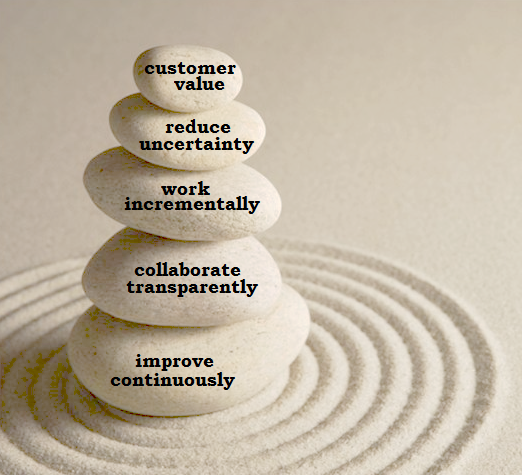What is Agile Marketing?
Agile marketing is hot, but it isn’t always clear what people mean by it. What is agile marketing? Every marketer wants to be agile, right? Marketing consultants want to convince you that whatever it is they are selling is agile marketing; it’s just hype right? Agile marketing is like being really fast and flexible to respond in real-time—like those Oreo Superbowl tweets, right? Well, yes and no.
The Five Disciplines of Agile Marketing
All of the above statements are true, but none of them is agile marketing. Agile marketing is a set of proven marketing management disciplines that accelerate marketing’s response to change, i.e., increase marketing agility. Think about that. Creating great marketing in an ever changing environment is a fundamental challenge of every modern marketing department. When change is the norm, the most agile marketer wins. And you’re saying that there are proven marketing management practices that will help my marketing team respond more quickly and effectively to change. I’m buying!
Agile marketing started in the Internet industry as an offshoot of agile software development, but its roots run much deeper into agile manufacturing and total quality management. It doesn’t get much more serious and proven than that. And, it doesn’t get much more general. Agile marketing can be applied to every marketing function from product to public relations, because responding to change and capitalizing on opportunity is a challenge that cuts across the entire marketing department.

Agile marketing is the serious practice of five fundamental agile marketing disciplines
that accelerate marketing’s response to change. When change is the norm, the most agile marketer wins.
So, what is agile marketing? If your first impression of agile marketing is Oreo tweets, SCRUM for marketing, or just some marketing consultant making stuff up, then please put it out your head. Agile marketing is not just doing stuff fast. Agile marketing is not defined by any one methodology. And agile marketing is definitely not hype. Agile marketing is the serious practice of five fundamental agile marketing disciplines. Applying any one of the five disciplines in any measure will increase your marketing agility. Applying them all will make you an agile marketing master.
through the Eyes of the Customer
First Discipline of Agile Marketing
Agile Marketing Goal: Do the Right Things Right
 Most marketing teams have a backlog of ideas that far exceeds their work capacity. How do you choose the right things to do? And, how do you make sure you are doing the right things right? The first agile marketing discipline requires that you rigorously prioritize each marketing project according to the value it creates in the eyes of your customers.
Most marketing teams have a backlog of ideas that far exceeds their work capacity. How do you choose the right things to do? And, how do you make sure you are doing the right things right? The first agile marketing discipline requires that you rigorously prioritize each marketing project according to the value it creates in the eyes of your customers.
Understanding the value of marketing from your customers’ perspective requires constant measurement. Your customer must say it, read it, write it, rate it, review it, share it, try it, buy it or recommend it to provide a measure of your work. Most modern marketing organizations are drowning in so much data that it is hard to separate the signal from the noise. Agile marketers know that marketing metrics that say nothing about customer value, say exactly that: nothing.
Good marketing metrics will tell you what customers like, but they won’t tell you why they like it. And, they won’t tell you how to improve it. Increasing customer value requires knowledge of your customers’ underlying needs and motivations. For that, you have to get real feedback from real people. Agile marketers let their customers be the judge, because marketing that provides no value in the eyes of the customer is waste.
by Reducing Uncertainty
Second Discipline of Agile Marketing
Agile Marketing Goal: Consistent performance, less rework and happier marketers
 Marketing is rife with uncertainty. Will this website upgrade be ready for launch? Will the press run my story? Will anyone respond to this ad? Surprisingly, we marketers do very little to manage it. Randomly shifting priorities, half-baked ideas and throwing spaghetti at the wall to see what sticks produce inconsistent results, create marketing rework, and undermine marketing team morale.
Marketing is rife with uncertainty. Will this website upgrade be ready for launch? Will the press run my story? Will anyone respond to this ad? Surprisingly, we marketers do very little to manage it. Randomly shifting priorities, half-baked ideas and throwing spaghetti at the wall to see what sticks produce inconsistent results, create marketing rework, and undermine marketing team morale.
Take this test. Pull out your marketing plan. Which items will absolutely happen when, where and how you expect them to happen? Which items might or might not? Which items are unlikely to produce any results at all, unless you get lucky? If you are like most marketers, your list will have a mix of all three. Why are they all on the same list?
The second discipline of agile marketing requires that you focus first on the marketing programs that you can do today and that you know will produce results, because they are certain to create real customer value. Half-baked ideas should sit on your backlog until they are fully baked and offer clear value in the eyes of the customer, otherwise you will waste precious marketing cycles on needless rework. Instead, use those extra cycles to design marketing experiments with the specific goal of reducing uncertainty.
Experimentation and risk-taking are essential to great marketing, but there should be a method to your madness. Can you separate prospects that are likely to buy from those that are not? Can you separate marketing activities that add value in the eyes of the customer from those that do not? Marketing experiments should help you focus your marketing efforts on the things that work. Throwing spaghetti is for amateurs.
by Working Incrementally
Third Discipline of Agile Marketing
Agile Marketing Goal: Win early, fail fast, and never miss an opportunity
 Big things move slower than small things. It’s simple physics. When change is the norm, big is bad. Shifting marketing priorities in the middle of a big project is a lose:lose scenario. You either throw away good work or you throw good money after bad. Moreover, big marketing projects tie up precious marketing resources for long periods of time without producing any customer value. Small marketing projects allow you to win earlier, fail faster and respond quicker to time-sensitive marketing opportunities.
Big things move slower than small things. It’s simple physics. When change is the norm, big is bad. Shifting marketing priorities in the middle of a big project is a lose:lose scenario. You either throw away good work or you throw good money after bad. Moreover, big marketing projects tie up precious marketing resources for long periods of time without producing any customer value. Small marketing projects allow you to win earlier, fail faster and respond quicker to time-sensitive marketing opportunities.
The third agile marketing discipline requires you to master the practice of breaking big projects up into small projects such that each small project delivers incremental value in the eyes of the customer. We all have some experience working incrementally. We’ve all made a list. But there is a lot more to the agile marketing discipline of incremental work than just making a list. You must create the list under the assumption that you will be interrupted again and again by shifting priorities, unforeseeable opportunities, and all manner of change. Small, valuable marketing projects maximize flexibility without sacrificing productivity, because you produce a continuous stream of value in the eyes of the customer.
The agile marketing discipline of incremental work is easy to apply to some marketing projects: a weekly blog post, a press release or our Oreo Twitter campaign all represent nice little nuggets of marketing value. But tweets are inherently small. Other projects, such as product launches, trade shows and ad campaigns present much greater challenges. However, it is when we apply the agile marketing discipline of incremental work to these seemingly monolithic projects that we reap the greatest benefits of agile marketing. Anyone can finish a blog post, but can you quickly and efficiently revamp your entire event calendar when you are asked to reduce your marketing budget by 20%?
through Transparency
Fourth Discipline of Agile Marketing
Agile Marketing Goal: Better ideas, better campaigns, and happier marketing stakeholders
 Everybody wants something from marketing. Sales wants leads. Support wants a community website. The CFO wants revenue. And every CEO has a pet marketing project. The agile marketing discipline of transparent collaboration arms you with the ability to manage these expectations by involving stakeholders in the marketing process and collaborating for the best possible results.
Everybody wants something from marketing. Sales wants leads. Support wants a community website. The CFO wants revenue. And every CEO has a pet marketing project. The agile marketing discipline of transparent collaboration arms you with the ability to manage these expectations by involving stakeholders in the marketing process and collaborating for the best possible results.
Imagine the VP of Sales who wants to see an upgrade to the website, because he believes the current site is causing his reps to lose deals. Never happens right? Do you…
- Negotiate with sales and settle on a 1 month website refresh that you know will take 3 months
- Collaborate with sales and start making small improvements this week
In scenario (a), sales has no skin in the game and no clue what it really takes to produce good marketing results. Scenario (b) creates buy-in through collaboration, provides immediate positive feedback and leaves sales wanting more.
The fourth agile marketing discipline of transparent collaboration requires that plans, risks and progress be visible to everyone inside and outside the marketing department. It requires that marketing decisions be reached through consensus based on reality. No hedging, no negotiations, just the facts. Finished marketing work that is clearly valuable in the eyes of the customer is the only measure of success. Transparent collaboration refocuses marketing relationships on performance over politics.
Fifth Discipline of Agile Marketing
Agile Marketing Goal: An unstoppable snowball of marketing success
 “Those who cannot remember the past are condemned to repeat it.” This famous assertion by the philosopher George Santayana is as applicable to marketing management as it is to political history. Does your marketing organization have a marketing memory? Is it shared by the entire marketing team? Or, does each marketer have her own plan, her own metrics, her own rolodex and her own private stash of important marketing artifacts.
“Those who cannot remember the past are condemned to repeat it.” This famous assertion by the philosopher George Santayana is as applicable to marketing management as it is to political history. Does your marketing organization have a marketing memory? Is it shared by the entire marketing team? Or, does each marketer have her own plan, her own metrics, her own rolodex and her own private stash of important marketing artifacts.
When you practice the first four agile marketing disciplines, you will naturally produce a shared marketing memory that is the foundation of continuous improvement. Understanding customer value requires constant customer feedback. Managing uncertainty entails a rigorous approach to experimentation and marketing project prioritization. Working incrementally creates detailed project management records. Transparency ensures that marketing knowledge is shared throughout the entire organization.
The fifth agile marketing discipline is the practice of putting that knowledge to good use. Shared marketing memory allows your marketing team to build on past learnings, rather than repeat past mistakes. Each nugget of customer feedback and each marketing experiment contributes to create a continuously learning, improving agile marketing machine. Each increment of customer value delivered builds upon the last to create an unstoppable snowball of agile marketing success.
Joel York
Latest posts by Joel York (see all)
- Marketing Teams that Drive Growth | Ebook - August 2, 2016
- 7 Marketing Management Lessons You Don’t Learn in B-School - May 17, 2016
- The ABC’s of Scaling Startup Marketing - April 11, 2016

1 Comment
[…] Agile marketers respond to change in Internet-time by applying five fundamental agile marketing disciplines. […]